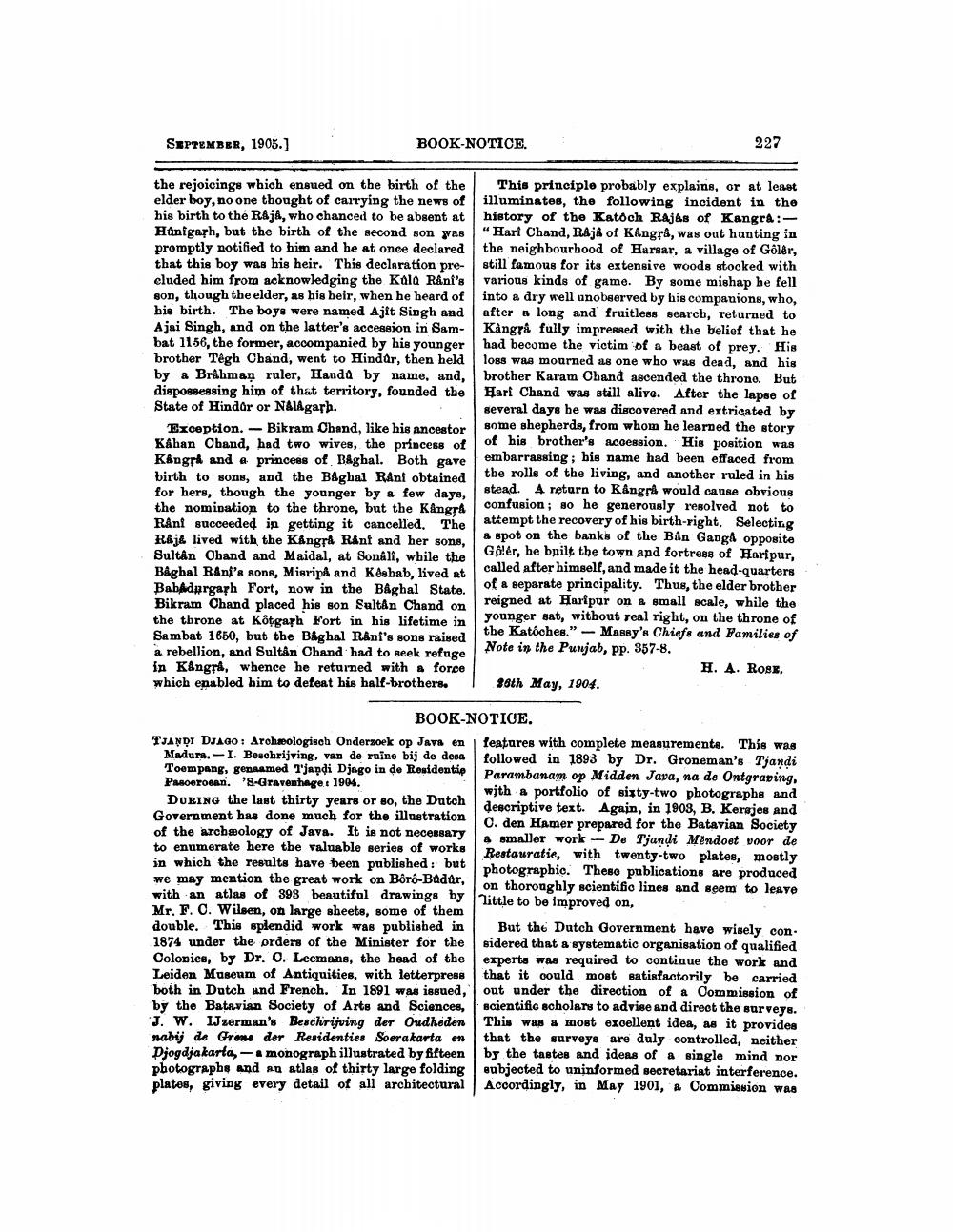________________
SEPTEMBER, 1905.)
BOOK-NOTICE.
227
the rejoicings which ensued on the birth of the elder boy, no one thought of carrying the news of his birth to the Raja, who chanced to be absent at Honigarh, but the birth of the second son yas promptly notified to him and be at once declared that this boy was his heir. This declaration precluded him from acknowledging the Kala Råni's son, though the elder, as his heir, when he heard of his birth. The boys were named Ajit Singh and Ajai Singh, and on the latter's accession in Sam- bat 1156, the former, accompanied by his younger brother Tégh Oband, went to Hindar, then held by a Brahman ruler, Handa by name, and, dispossessing him of that territory, founded the State of Hindar or Nalagarh.
Exception. - Bikram Chand, like his ancestor KAhan Oband, had two wives, the princess of Kangrå and a princess of Raghal. Both gave birth to sons, and the B&gbal Rani obtained for hers, though the younger by a few days, the nomination to the throne, but the Kingså Rånt succeeded in getting it cancelled. The Raj& lived with the Kångpå Rånt and her sons, Sultân Chand and Maidal, at Sonali, while the Båghal Rani's sons, Misripå and Keshab, lived at BabAdargaph Fort, now in the Bâghal State. Bikram Chand placed his son Sultan Chand on the throne at Kôtgarh Fort in his lifetime in Sambat 1850, but the Båghal Rani's sons raised à rebellion, and Sultân Chand had to seek refuge in Kångra, whence he returned with force which enabled him to defeat his half-brothers. 1
This principle probably explains, or at least illuminates, the following incident in the history of the Katoch Rajas of Kangra :"Harl Chand, Raja of Kangrå, was out hunting in the neighbourhood of Harsar, a village of Göler, still famous for its extensive woods stocked with various kinds of game. By some mishap he fell into a dry well unobserved by his companions, who, after = long and fruitless search, returned to Kangrå fully impressed with the belief that he had become the victim of a beast of prey. His loss was mourned as one who was dead, and his brother Karam Ohand ascended the throne. But Harl Chand was still alive. After the lapse of several days he was discovered and extricated by some shepherds, from whom he learned the story of his brother's accession. His position was embarrassing; his name had been effaced from the rolls of the living, and another ruled in his stead. A return to Rângra would cause obvious confusion; so he generously resolved not to attempt the recovery of his birth-right. Selecting & spot on the banks of the Ban Ganga opposite Gê!ér, he built the town and fortress of Haripur, called after himself, and made it the head-quarters of a separate principality. Thus, the elder brother reigned at Haripur on & small scale, while the younger sat, without real right, on the throne of the Katãohes." - Massy's Chiefs and Families of Note in the Punjab, pp. 357-8.
H. A. Rose 36th May, 1904.
BOOR-NOTICE. TJANDI DJAGO: Archæologisch Ondersoek op Java en features with complete measurements. This was
Madura. - I. Beschrijving, van de ruine bij de desa followed in 1893 by Dr. Groneman's Tjandi Toompang, genaamed T'japdi Djago in do Residentip
Parambanam op Midden Java, na de Ontgraping, Pasoeroean. 's-Gravenhaget 1904.
with a portfolio of sixty-two photographs and DURING the last thirty years or so, the Dutch
descriptive text. Again, in 1903, B. Kerajes and Government has done much for the illustration
C. den Hamer prepared for the Batavian Society of the archeology of Java. It is not necessary
& smaller work - De Tjandi Méndoet voor de to enumerate here the valuable series of works
Restauratie, with twenty-two plates, mostly in which the results have been published: but
photograpbio. These publications are produced we may mention the great work on Bôrô-Badar,
on thoroughly scientifio lines and seem to leave with an atlas of 398 beautiful drawings by
little to be improved on, Mr. F. O. Wileen, on large sheets, some of them double. This splendid work was published in But the Dutch Government have wisely con. 1874 under the orders of the Minister for the sidered that a systematic organisation of qualified Colonies, by Dr. O. Leemans, the head of the experts was required to continue the work and Leiden Museum of Antiquities, with letterpress that it could most satisfactorily be carried both in Dutch and French. In 1891 was issued, out under the direction of a Commission of by the Batavian Society of Arts and Sciences, scientific scholars to advise and direct the surveys. J. W. IJzerman's Beschrijving der Oudheden This was a most excellent idea, as it provides nabij de Grone der Residenties Soerakarta en that the surveys are duly controlled, neither Djogdjakarta, - a monograph illustrated by fifteen by the tastes and ideas of a single mind por photographs and an atlas of thirty large folding subjected to uninformed secretariat interference. plates, giving every detail of all architectural Accordingly, in May 1901, a Commission was




